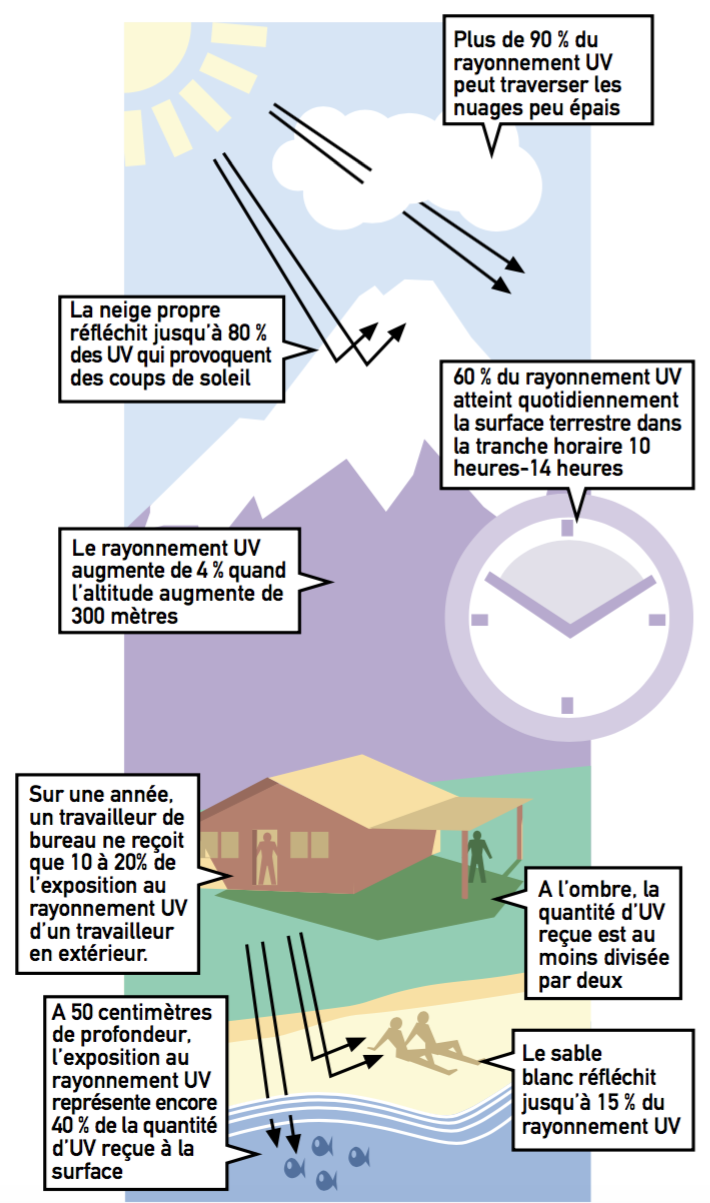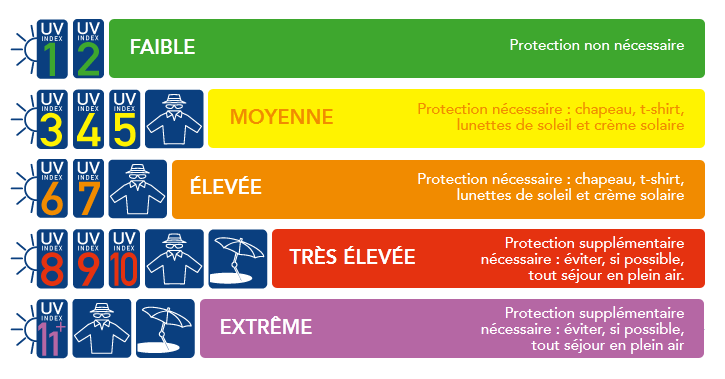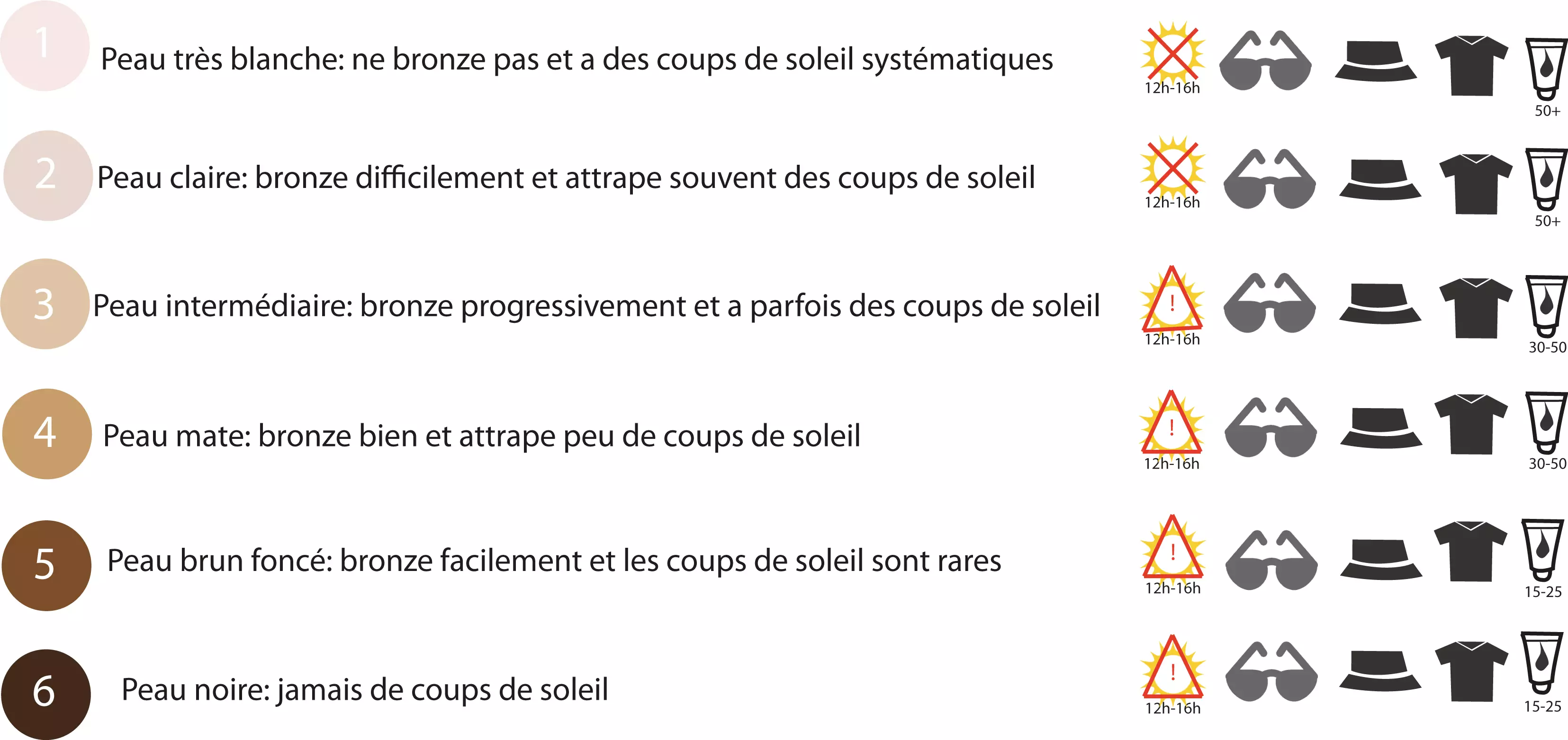RADIATION UV
The sun does wonders for your morale and helps produce vitamin D, yes! But we sometimes forget that it can also present risks. In mainland France, the sun's rays are most intense between May and August, so all your outdoor activities, whether in your garden, on a café terrace, at the beach, in the mountains or in the countryside, when you're playing sport or just out for a walk.... Protect yourself so that the sun remains a pleasure! French Ministry of Health and Sports.
Everyone is exposed to UV radiation, both from the sun and from the many artificial sources used in industry, commerce and leisure. The sun emits light, heat and UV rays. The ultraviolet region of the solar spectrum corresponds to wavelengths 100-400nm, and is divided into three bands (see attached). As it passes through the atmosphere, all UVC and almost 90% of UVB are absorbed by ozone, water vapour, oxygen and carbon dioxide. UVA radiation is less modified by the atmosphere.
SUN HEIGHT The higher the sun is in the sky, the greater the UV radiation. As a result, UV radiation varies with the time of day and the month of the year. Outside the tropics, radiation is highest when the sun is at its highest, around midday in the summer months. NEBULOSITY UV radiation is highest in the absence of cloud cover, but can still be significant despite clouds. Scattering can have the same effect as reflection on different surfaces, and therefore increases total UV radiation. ALTITUDE As altitude increases, the atmospheric layer absorbs less UV radiation, because it is thinner. For a 1000-meter increase in altitude, UV radiation rises by 10 to 12%. LATITUDE The closer we get to equatorial regions, the greater the UV radiation. OZONE Ozone absorbs part of the UV radiation, preventing it from reaching the Earth's surface in its entirety. The thickness of the ozone layer varies with the time of year, and even during the day. REFLECTION BY THE EARTH'S SURFACE UV radiation is reflected or scattered to a greater or lesser extent depending on the surface: fresh snow can reflect up to 80% of UV radiation, dry beach sand around 15% and sea foam on the ocean surface around 25%.


According to the French Ministry of Health and Sport, ultraviolet rays can cause irreversible damage, and in the most serious cases, death. In excessive doses, exposure to UV rays causes sunburn. The skin is red and painful. It then peels, signaling the death of millions of cells. The deeper the layers of the skin are affected, the more severe the sunburn. At the same time, repeated sunburns greatly increase the risk of skin cancer, especially if they occurred during childhood. VIGILANCE IN CHILDHOOD With skin thinner than that of adults, and unprepared for the sun, children must be the focus of our attention. At birth, each individual has a sun capital that will help him or her fight against a given quantity of UV rays. When this capital is depleted, the body is no longer able to repair the damage caused by the sun. And the earlier a child is exposed to the sun, the more his or her sun capital is depleted. To save this reserve, the only solution is to adopt effective protection from an early age. RISKS - To the skin: sunburn, premature aging, allergies, cancer (melanoma and carcinoma). - For the eyes: serious lesions can appear in the short term, such as ophthalmia (sunburn of the eye), or in the longer term, such as cataracts or retinal degeneration.
To communicate the level of risk associated with exposure to the sun, the World Meteorological Organization and the World Health Organization recommend the use of a universal scale known as the UV Index. This numerical index (from 1 to 11+, i.e. 11 and over) reflects the intensity of ultraviolet radiation and its health impact on the skin.


It's easy enough to calculate the number of minutes you can safely stay in the sun. Below you'll find a UV index figure for each phototype. This is the only figure you need to remember. Divide this figure by the UV index level and you have the number of minutes you are protected. Example: You're type 3, so your UV index number is 200. When the UV index is level 7, you divide 200 by 7. You can therefore safely stay in the sun for around 30 minutes. If you want/need to stay in the sun longer, you need to protect yourself from UV rays. According to the Federation Against Cancer.
MAXIMUM TIME IN THE SUN 67 / UV INDEX
MAXIMUM TIME UNDER THE SUN 100 / UV INDEX
MAXIMUM TIME UNDER THE SUN 200 / UV INDEX
MAXIMUM TIME UNDER THE SUN 300 / UV INDEX
